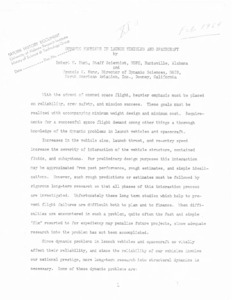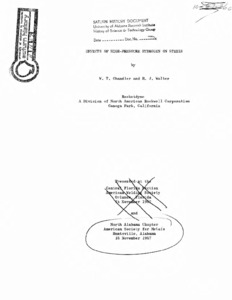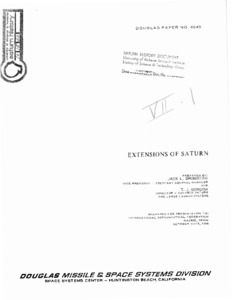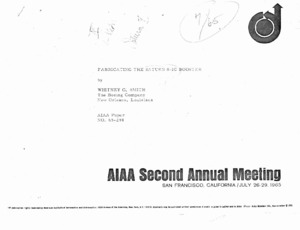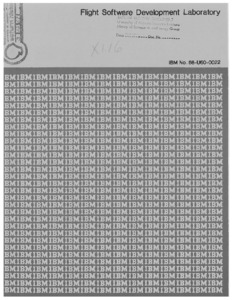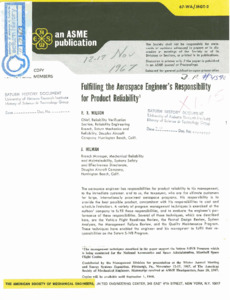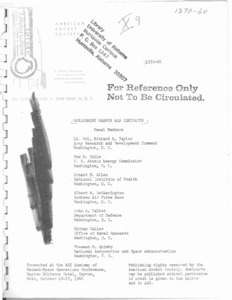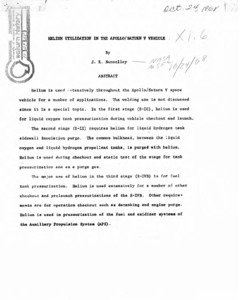
Browse Items (165 total)
Sort by:
-
"Dynamic Environments of the S-IV and S-IVB Saturn Vehicles."
The vibration and acoustic environments of the S-IV and S-IVB Stages of the Saturn vehicle are summarized. A brief review of techniques used to predict the dynamic environments of the S-IV and S-IVB vehicles is presented. This review includes discussions on the prediction of rocket exhaust noise, boundary layer noise, sinusoidal vibrations, and random vibrations for the S-IV and S-IVB vehicles. In addition, sine-random vibration conversions are given. -
"Dynamic Problems in Launch Vehicles and Spacecraft."
Addresses improving spacecraft safety by resolving various known dynamic problems. -
"Effects of High-Pressure Hydrogen on Steels."
Hydrogen embrittlement of steels is hardly a new subject, but the effects of high-pressure hydrogen have been treated in detail only more recently and to a much more limited extent. Thus, most investigations of hydrogen embrittlement have been concerned with hydrogen in metals, while for the high-pressure hydrogen problem, we are more concerned with metals in(in contact with) hydrogen. I believe there is a difference and, certainly,different mechanisms of embrittlement are at least possible.; Presented at the Central Florid Section, American Welding Society, Orlando, Florida, 14 November 1967 and North Alabama Chapter, American Society for Metals, Huntsville, Alabama, 16 November 1967. -
"Engineering Safety Into Missile-Space Systems."
Safety Engineering, as applied to complex missile and space systems, has developed a new methodology referred to as "System Safety Engineering." The requirement for a comprehensive approach to safety which is included as a contractually covered adjunct to the design, development, and operational phases of a systems life cycle has become apparent from costly missile mishap experience. The general concepts and accomplishments of this new engineering discipline are described along with possible beneficial relationships with Reliability and other recognized organizational elements engaged in safety related activities. -
"Extensions of Saturn."
This paper discusses the possible applications of Saturn vehicles to future space exploration. Potential missions utilizing Apollo derived hardware are examined. Research, development, and operations in earth orbit as well as lunar exploration, unmanned and manned interplanetary exploration are reviewed. These hypothetical missions are discussed in the context of the present and potential capability of three configurations of the Saturn vehicle; an uprated Saturn I, a three-stage Saturn V and a four-stage Saturn V. NOTE: Work presented herein was conducted by the Douglas Missiles and Space Systems Division under company-sponsored research and development funds. Therefore, the concepts and objectives described within this paper reflect the opinions of the authors and do not necessarily constitute endorsement by NASA, the Air Force, or any other U.S. Government organization. The nominal performance numbers presented are typical of the current configurations and possible future vehicle configurations. -
"Fabricating the Saturn S-IC Booster."
AIAA Second Annual Meeting, San Francisco, California. Discusses the fabrication process of the Saturn S-IC booster. -
"Flight Software Development Laboratory."
A man-in-the-loop computer facility has been created using a digital computer, display terminal,and space vehicle flight computer to enable programmers to check out flight programs in a simulated space flight environment. The simulation requires a real time multi-programmed environment, which is supplied by a control system capable of scheduling programs on 32 levels of priority interrupt as well as answering demands for service at the display terminal. A special interface device permits visibility and control of the flight program as it executes in the flight computer. On-line inputs from the programmer at the display terminal and outputs from data collection and reduction routines to the display screen are executed in real time. The Flight Software Development Laboratory has proved to be very useful in reducing program preparation time and increasing flight program confidence. -
"Fulfilling the Aerospace Engineer's Responsibility for Product Reliability."
The management techniques described in the paper support the Saturn S-IVB Program which is being conducted for the National Aeronautics and Space Administration, Marshall Space Flight Center. -
"Government Grants & Contracts."
The Army medical contract, grant, and research interest in the bio-science area. -
"Helium Utilization in the Apollo/Saturn V Vehicle."
Helium is used extensively throughout the Apollo/Saturn V space vehicle for a number of applications. The welding use is not discussed since it is a special topic. In the first stage (S-IC), helium is used for liquid oxygen tank pressurization during vehicle checkout and launch.

